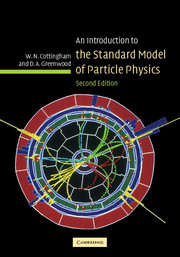Book contents
- Frontmatter
- Contents
- Preface to the second edition
- Preface to the first edition
- Notation
- 1 The particle physicist's view of Nature
- 2 Lorentz transformations
- 3 The Lagrangian formulation of mechanics
- 4 Classical electromagnetism
- 5 The Dirac equation and the Dirac field
- 6 Free space solutions of the Dirac equation
- 7 Electrodynamics
- 8 Quantising fields: QED
- 9 The weak interaction: low energy phenomenology
- 10 Symmetry breaking in model theories
- 11 Massive gauge fields
- 12 The Weinberg–Salam electroweak theory for leptons
- 13 Experimental tests of the Weinberg–Salam theory
- 14 The electromagnetic and weak interactions of quarks
- 15 The hadronic decays of the Z and W bosons
- 16 The theory of strong interactions: quantum chromodynamics
- 17 Quantum chromodynamics: calculations
- 18 The Kobayashi–Maskawa matrix
- 19 Neutrino masses and mixing
- 20 Neutrino masses and mixing: experimental results
- 21 Majorana neutrinos
- 22 Anomalies
- Epilogue
- Appendix A An aide-mémoire on matrices
- Appendix B The groups of the Standard Model
- Appendix C Annihilation and creation operators
- Appendix D The parton model
- Appendix E Mass matrices and mixing
- References
- Hints to selected problems
- Index
8 - Quantising fields: QED
Published online by Cambridge University Press: 05 September 2012
- Frontmatter
- Contents
- Preface to the second edition
- Preface to the first edition
- Notation
- 1 The particle physicist's view of Nature
- 2 Lorentz transformations
- 3 The Lagrangian formulation of mechanics
- 4 Classical electromagnetism
- 5 The Dirac equation and the Dirac field
- 6 Free space solutions of the Dirac equation
- 7 Electrodynamics
- 8 Quantising fields: QED
- 9 The weak interaction: low energy phenomenology
- 10 Symmetry breaking in model theories
- 11 Massive gauge fields
- 12 The Weinberg–Salam electroweak theory for leptons
- 13 Experimental tests of the Weinberg–Salam theory
- 14 The electromagnetic and weak interactions of quarks
- 15 The hadronic decays of the Z and W bosons
- 16 The theory of strong interactions: quantum chromodynamics
- 17 Quantum chromodynamics: calculations
- 18 The Kobayashi–Maskawa matrix
- 19 Neutrino masses and mixing
- 20 Neutrino masses and mixing: experimental results
- 21 Majorana neutrinos
- 22 Anomalies
- Epilogue
- Appendix A An aide-mémoire on matrices
- Appendix B The groups of the Standard Model
- Appendix C Annihilation and creation operators
- Appendix D The parton model
- Appendix E Mass matrices and mixing
- References
- Hints to selected problems
- Index
Summary
We turn now to the quantisation of the electrodynamic fields introduced in Chapter 7. So far we have treated the electromagnetic field and the Dirac field as classical fields (though we were compelled in Chapter 7 to recognise that Dirac fields anticommute). On quantisation, these fields become operator fields, acting on the states of a system. The classical total field energy becomes the Hamiltonian operator, which determines the dynamics of the system. We shall use the formalism of annihilation and creation operators; this formalism is reviewed briefly in Appendix C for readers not already familiar with it.
Quantum electrodynamics, or QED, is an important component of the Standard Model. It is also the foundation of our understanding of the material world at the atomic level. However, we do not wish to enter into the technical complications of electrons in atoms or in material media. In this chapter we shall only consider more simple situations of a few interacting photons, electrons and positrons, at energies sufficiently high for bound systems of electrons and positrons to be ignored. In these situations, the free field approximation to QED provides a sound basis for understanding the interactions of particles as perturbations on their free behaviour.
This is not a text on quantum field theory, and our outline of perturbation theory in this chapter is necessarily sketchy. But our intention is to try to give some insight into how the results of calculations, presented in later chapters, are arrived at.
- Type
- Chapter
- Information
- Publisher: Cambridge University PressPrint publication year: 2007



